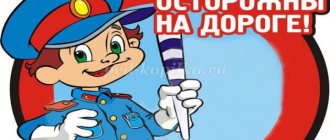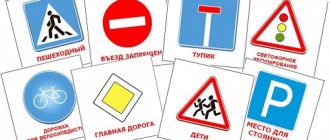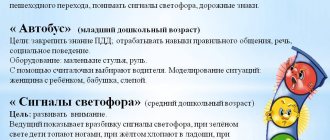Conversation on the topic: “Road and children”
Conversation on the topic: “Road and children”
Purpose of the conversation: Activation of children's activities to teach the rules of safe behavior on the roads and the prevention of children's road traffic injuries.
All activities carried out are aimed at: 1. Expanding children’s knowledge about the rules of behavior on the road and the ability to apply the acquired knowledge about the rules of the road in games and in everyday life. 2.Uniting the efforts of teachers and parents to familiarize children with the rules of the road and their observance in life. 3.Development of visual materials that have a developmental and cognitive impact on children
Objectives : Generalize and expand children's knowledge about traffic rules. To develop the psychophysiological qualities of the child, ensuring his safety in the process of road traffic. Foster patriotic feelings for your hometown. Instill responsibility for the safety of your life and the lives of other people. Reinforce the need to comply with traffic rules.
Progress of the conversation:
Hello guys! Today we will talk to you about what you need to do to save your life on the roads. Do you know? That's right, you need to follow the traffic rules. Let's remember them all. Rule #1. Where can you cross the road? That's right, you can only cross the road at pedestrian crossings. They are marked with a special “pedestrian crossing” sign. Look here (shows a sign). Guys, do you know what is the safest crossing? This is underground. It is designated like this (shows a sign). Rule #2. If there is no underground crossing, you must use a crossing with a traffic light. Do you know the traffic lights? Right. "Red man" means "stop!" and "green man" means "go!" Rule No. 3. You cannot cross the road at a red light, even if there are no cars. Rule #4. When crossing the road, you should always look both ways. Where should we look first? Yes, first go left, and when you reach the middle of the road, go right. Rule #5. It is safest to cross the road with a group of pedestrians. Even stray dogs who do not know the rules of the road understand this. Under no circumstances should you run out onto the road. You have to stop before the road. Guys, why can’t you run out onto the road? Can you play on the road? Why? Right. This is rule number 6. You cannot play on the roadway or on the sidewalk. Guys, if your parents have forgotten which side you need to go around a bus, trolleybus and tram, you can remind them that: A bus and a trolley bus at a stop should only be bypassed from behind, and a tram can only be bypassed from the front. Agreed? Well done guys! Remember all the rules. This is cool!
Game “Think - Guess!” Objectives: to activate the processes of thinking, attention and speech of children; clarify your understanding of transport and traffic rules; cultivate intelligence and resourcefulness. Rules: you must give the correct answer and not shout it out in unison. The one who gets more chips for correct answers wins. I will ask you questions. Anyone who knows the correct answer should raise their hand. Whoever answers correctly first gets a chip. At the end of the game we will count the chips and reveal the winner.
Questions: - How many wheels does a car have? (4) — How many people can ride one bike? (1) - Who walks on the sidewalk? (pedestrian) - Who is driving the car? (Driver) - What is the name of the place where two roads intersect? (Intersection) - What is the roadway for? (for traffic) - On which side of the roadway is traffic moving? (On the right) - What can happen if a pedestrian or driver violates traffic rules? (Accident or traffic accident) - What is the top light at the traffic light? (Red) - At what age are children allowed to ride a bicycle on the street? (from 14 years old) - How many signals does a pedestrian traffic light have? (Two) - How many signals does a pedestrian traffic light have? (Three) - What animal does a pedestrian crossing look like? (At the zebra crossing) - How can a pedestrian get into the underground passage? (Down the stairs) - If there is no sidewalk, where can a pedestrian move? (On the side of the road on the left, towards traffic) - Which cars are equipped with special sound and light signals? (“Ambulance”, fire and police vehicles) - What is the traffic police inspector holding in his hand? (Rod) - Where should you play so as not to be in danger? (In the yard, on the playground)
Thematic conversation on traffic rules for grades 1-2. Abstract: Public transport
Thematic conversation on the topic: “Public transport” for grades 1-2
Author: Panfilova Nadezhda Pavlovna, primary school teacher MBOU “Razdolnenskaya school-gymnasium No. 2 named after L. Ryabika” Republic of Crimea
Traffic rules in elementary school. Thematic conversation for grades 1-2 “Public transport”
Description: the summary of the conversation will be of interest to primary school teachers, educators, additional education teachers, and caring parents. Introduce the rules of a pedestrian, broaden their horizons, give an idea of the dangers on the road - teach the child to live and act in real life. Purpose: familiarization with the rules of behavior in public transport and outside it. Objectives: .give an idea of the distinctive features of public transport, .expand knowledge about the rules of behavior on the road, .teach to be educated passengers in public transport, .instill responsibility for one’s life.
Progress of the conversation.
Motivation for cognitive activity. Conversation. The School of Traffic Sciences begins its lesson. -What is traffic rules? (Road rules.) -Why is it necessary to know the rules? -How do you understand the words “dangerous situation on the road”? -What could be the reason for such situations? Teacher. Traffic rules are a road map. Everyone should own one to prevent accidents. Updating basic knowledge. The game "Who is more faithful and faster." (Choose three inspectors. Students ask them different questions related to road safety. The game can be repeated several times.) 1. What parts does the street consist of? (Sidewalks and roadways, intersections) 2. Where can people walk? 3. Where can you cross the street? (At pedestrian crossings, which can be above-ground, underground, or overground.) 4. If you cross the roadway at a zebra crossing, where should you look first? (To the left, and in the middle - to the right.) 5. What does a pedestrian crossing indicate? (Traffic light, zebra crossing, road sign.) 6. At what traffic light can you cross the road? (On green.) (Awarding the best inspectors with prizes. Reporting the topic of the lesson. Today we will talk about transport on city streets. For the rapid movement of people over short and long distances, there is transport. -What is it called? Public transport - vehicles designed for transportation a large number of passengers and run on certain routes.
As soon as we buy a ticket for any type of public transport, we are passengers.
Work in groups. (There are 4 students in the group. - Let’s determine what public transport you took to get to school? To do this, each group collects a picture puzzle. (Attach the finished work to the board.) Guess the riddles. Doesn’t fly, doesn’t buzz, A beetle is running down the street. And two brilliant lights burn in the eyes of the beetle. (Car) (M. Doroshin.) A house goes down the street, Taking everyone to work. Not on thin chicken legs, But in rubber boots. (Bus.) (M. Doroshin.)
-Find something in common with the car. Establish differences with the car. (Big, small, many passengers.) (Does without wires, can travel where a trolleybus and tram cannot go. Buses and cars pollute the air with exhaust gases. This is very bad.) -Where do people use such public transport? Physical education We rode a horse, got to the corner, got into the car, poured gasoline. We drove by car and reached the river. Trrr! Stop! U-turn. We need to get on the plane. The plane is flying, the engine is humming: -U-U-U! Early in the morning outside the window - Knocking and ringing and chaos: Red houses walk along straight steel paths. (Tram.)
A tram is an electric rail public transport. It has an arc on the roof that moves along an electrical wire located at the top. The current flows through the arc to the tram engine, and through the engine to the wheels. -What are the differences with the bus? -Where do people use such transport? Guess what it is: Not a bus, not a tram, Doesn’t need gasoline, Even though the wheels are on rubber. (Trolleybus.)
Amazing carriage! Judge for yourself: The rails are in the air, and he holds them with his hands! (Trolleybus.) -How does a trolleybus differ from a tram? What common? -Where do people use such transport? -What should a driver of any public transport be like? (Attentive, experienced, knowledgeable, smart, healthy, polite.) Rules of conduct for passengers in public transport. -Tell me the rules of behavior at a bus stop, in transport? (Children's answers.) Don't linger in the aisle. .Pay the fare. .Don't litter, don't make noise, don't distract the will. .Do not lean out of vehicle windows. .Give your seat to older people and passengers with children. (Reading, repetition) -How should you get on public transport? (Through the back door.) -What about getting out of the transport? (Through the front door.) How to get around the TRAM? Remember! A stationary tram is bypassed from the FRONT!!!
When exiting the tram, you need to look to the right and, making sure it is safe, go to the sidewalk. Remember! A stationary bus and a trolleybus are bypassed from the BACK!
Role-playing game “We are passengers.” Goal: to practice the rules of behavior of passengers at a bus stop, in transport, when exiting a transport. Let's distribute the roles: driver, pedestrians, passengers, inspector. (Make transport out of chairs in advance.) -Boarding the bus. -Disembarkation of passengers and walk around the bus. (Trolleybus, tram.) Result of the conversation. — What happens if we violate the rule of bypassing traffic?
-Who will you tell about what you learned in class? The lesson at the School of Road Sciences is over.
We recommend watching:
Class hour on the topic: Traffic rules, grade 2 Texts with answers for conversations on traffic rules in grade 1 Extracurricular lesson on traffic rules on the topic “Question and answer on traffic rules,” grade 2 Crossword puzzle with questions and answers on traffic rules for schoolchildren 2 — 4 classes
Similar articles:
Traffic rules in elementary school
Traffic rules quiz for elementary school with answers
Sketch on traffic rules for students in grades 3 - 4
Drama on traffic rules for elementary school
Conversation on traffic rules in elementary school. Rules for pedestrians






